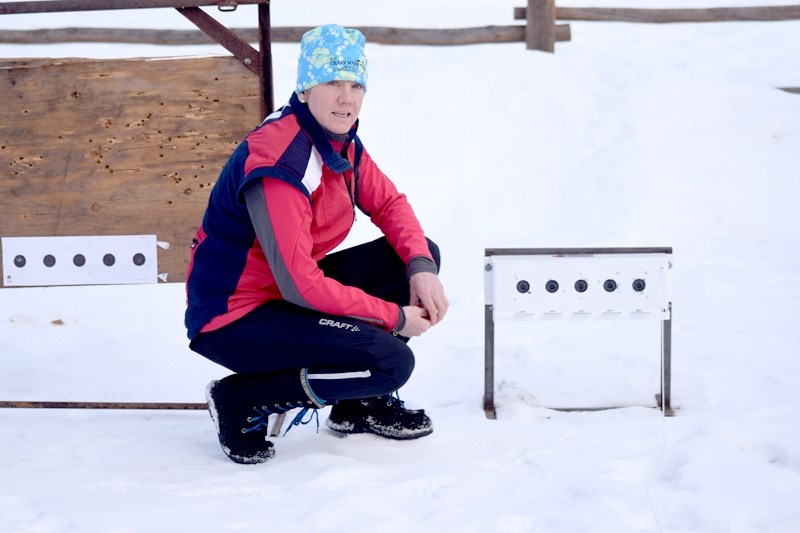Biathlon is a natural for 12-year-old Henrik Quintilio, a Barrhead County resident, who travelled this past weekend to Medicine Hat to compete in the Alberta Winter Games, but that might not come as a surprise to anyone who knows the Quintilio family.
That’s because Henrik’s parents, Kevin and Ntala Quintilio, competed on the World Cup circuit from 1993 to 1998. Ntala, then known as Ntala Skinner, for the United States team and Kevin for Canada. Besides racing on the World Cup circuit, Ntala qualified for both the 1994 Olympics in Lillehammer, Norway (although she didn’t race) and 1998 in Nagano, Japan. Kevin also qualified for the 1998 Olympics for Canada.
After the couple retired from racing they first settled in Edmonton before moving to Whitecourt and eventually Barrhead County, where they operate the Crazy Mare Ranch.
“So our kids come quite naturally to the sport,” she said, adding Henrik’s younger sister Antija also participates in Biathlon.
Biathlon is a winter sport that combines cross-country skiing and rifle shooting disciplines, Ntala explained to the Leader, during one of the kid’s practice sessions on Monday, Feb. 8.
The biathlon starts with competitors starting out cross-country skiing, before they have to stop and shoot at a number of small targets a distance away, in a prone and a standing stance.
“Depending on their age,” Ntala said. “Competitors either have to use an air rifle or a .22 calibre rifle.”
Henrik’s category age group is an air rifle. In a couple of years, he will transition to using a .22 calibre rifle. Another difference between the age categories is at earlier ages, competitors don’t have to carry their own rifle.
“It is a little bit different when I first started. Back then we all had to pack along our rifles when we skied along the path,” she said, adding now competitors have to wait until the’re 15-years-old, which is about the same time they usually transition to the .22 calibre rifle.
For the most part, both Henrik an Antija have been lucky having parents who are familiar with the sport, equipment and space to practice.
Ntala said not all people, especially youth, are that lucky. Besides Edmonton, whose Nordic Ski Club has a subsection of its organization dedicated to biathlon, there are not a lot of clubs or organizations who are able, or prepared to offer the sport. Other locations, which have a biathlon course, are Hinton, Canmore and Grande Prairie.
The biggest problem is having not only property large enough for up to a 10-kilometre course, although in biathlon the course is circuit and participants complete their distance by doing a number of laps, it must have the ability to include a gun range capable of handling a .22 calibre rifle, ideally located in a central part of the ski course.
Biathlon can also be an expensive sport to get into. Besides the clothing, a proper biathlon uniform and cross-country skiing equipment there is the cost of the rifle.
“It’s not just an ordinary air rifle or .22 calibre rifle. It has to meet exacting standards and has to be very accurate,” she said, adding it isn’t uncommon for an air rifle to cost upwards of $3,500. “We were lucky to be able to rent the ones we have from Alberta biathlon.”
Luckily for people getting into biathlon, they don’t necessarily need to buy all the equipment.
“Biathlon is actually a very small community and everybody knows each other and helps each other where they can,” Ntala said, adding in the younger age groups, because the athletes don’t have to carry their rifles, organizers can keep them at the shooting area where a number of different athletes can use them.
As for how Henrik got into the sport, he said after he completed his practice laps with his training partner and sister, it is something he always wanted to do.
Like many biathletes, he said he first started out cross-country skiing, but about two-years ago decided he wanted add shooting into the mix.
“I really like shooting,” Henrik said. “My favourite part is skiing as hard as you can and then coming into the range, calming your breathing down and shooting clean.”
Although Henrik said he is excited about being able to represent Zone 5, which Barrhead is in, he is disappointed he won’t be able to compete in a true biathlon.
Like many areas of Alberta, Medicine Hat is experiencing a warmer than normal winter and has no snow. Instead of cancelling the event, or moving it to another location, organizers decided to change the cross country skiing portion of the biathlon to a run.



